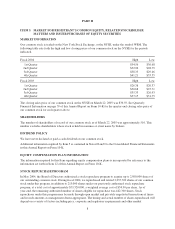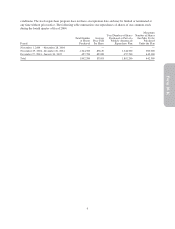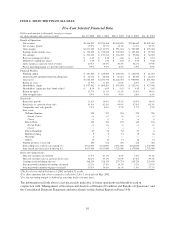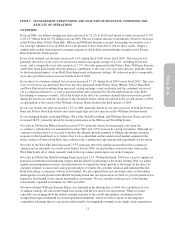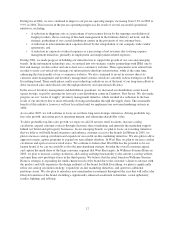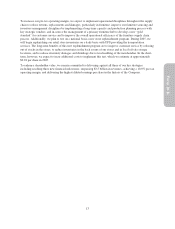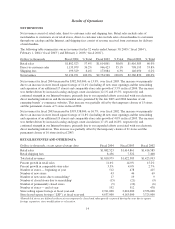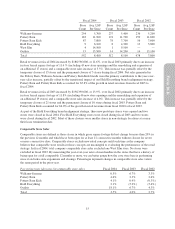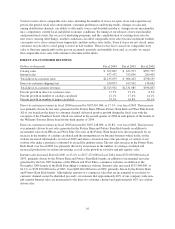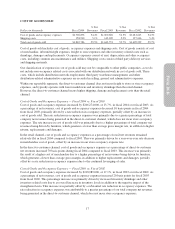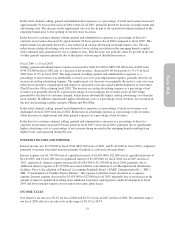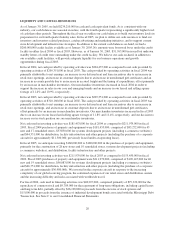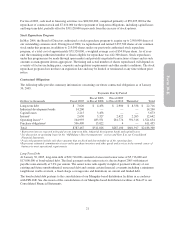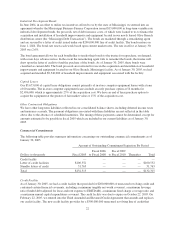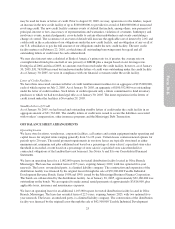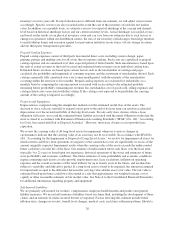Pottery Barn 2004 Annual Report Download - page 23
Download and view the complete annual report
Please find page 23 of the 2004 Pottery Barn annual report below. You can navigate through the pages in the report by either clicking on the pages listed below, or by using the keyword search tool below to find specific information within the annual report.
Various factors affect comparable store sales, including the number of stores we open, close and expand in any
period, the general retail sales environment, consumer preferences and buying trends, changes in sales mix
among distribution channels, our ability to efficiently source and distribute products, changes in our merchandise
mix, competition, current local and global economic conditions, the timing of our releases of new merchandise
and promotional events, the success of marketing programs, and the cannibalization of existing store sales by
new stores. Among other things, weather conditions can affect comparable store sales because inclement weather
can require us to close certain stores temporarily and thus reduce store traffic. Even if stores are not closed, many
customers may decide to avoid going to stores in bad weather. These factors have caused our comparable store
sales to fluctuate significantly in the past on an annual, quarterly and monthly basis and, as a result, we expect
that comparable store sales will continue to fluctuate in the future.
DIRECT-TO-CUSTOMER REVENUES
Dollars in thousands Fiscal 2004 Fiscal 2003 Fiscal 2002
Catalog sales $ 657,607 $ 633,573 $597,793
Internet sales 477,472 332,850 200,402
Total direct-to-customer sales $1,135,079 $ 966,423 $798,195
Direct-to-customer shipping fees 190,873 165,562 138,642
Total direct-to-customer revenues $1,325,952 $1,131,985 $936,837
Percent growth in direct-to-customer sales 17.5% 21.1% 8.5%
Percent growth in number of catalogs circulated 12.1% 17.4% 14.1%
Percent growth in number of pages circulated 19.5% 16.8% 16.1%
Direct-to-customer revenues in fiscal 2004 increased by $193,967,000, or 17.1%, over fiscal 2003. This increase
was primarily driven by net sales generated in the Pottery Barn, PBteen, Pottery Barn Kids and West Elm brands.
All of our brands in the direct-to-customer channel delivered positive growth during the fiscal year with the
exception of the Chambers brand, which was retired in the second quarter of 2004 in anticipation of the launch of
the Williams-Sonoma Home brand in the third quarter of 2004.
Direct-to-customer revenues in fiscal 2003 increased by $195,148,000, or 20.8%, over fiscal 2002. This increase
was primarily driven by net sales generated in the Pottery Barn and Pottery Barn Kids brands in addition to
incremental sales from PBteen and West Elm. Net sales in the Pottery Barn brand were driven primarily by an
increase in the number of catalogs circulated and the momentum in our Internet business where traffic on the
website increased substantially over fiscal 2002 and where conversion rates (the percentage of visitors to our
website who make a purchase) continued to exceed the industry norm. The net sales increase in the Pottery Barn
Kids brand over fiscal 2002 was primarily driven by an increase in the number of catalogs circulated and
increased productivity in on-line advertising, as well as the growth in our baby and gift registry sales.
Internet sales increased $144,622,000, or 43.4%, to $477,472,000 in fiscal 2004, from $332,850,000 in fiscal
2003, primarily driven by the Pottery Barn and Pottery Barn Kids brands, in addition to incremental net sales
generated by the late 2003 launches of the PBteen and West Elm e-commerce websites, in addition to the
November 2004 launch of the Hold Everything e-commerce website. Internet sales increased $132,448,000, or
66.1%, to $332,850,000 in fiscal 2003, from $200,402,000 in fiscal 2002, primarily driven by the Pottery Barn
and Pottery Barn Kids brands. Although the amount of e-commerce sales that are incremental to our direct-to-
customer channel cannot be identified precisely, we estimate that approximately 40% of our company-wide non-
gift registry Internet sales are incremental to the direct-to-customer channel and approximately 60% are catalog-
driven sales.
16




